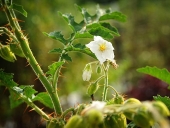
 13
13




A build too cool to miss:Mike's GreenhouseA great example:Joseph's Garden
All the soil info you'll ever need:
Redhawk's excellent soil-building series





 3
3




Visit Redhawk's soil series: https://permies.com/wiki/redhawk-soil
How permies.com works: https://permies.com/wiki/34193/permies-works-links-threads
 2
2




Jay Angler wrote:We have a wild plum in our field and although its fruit is quite small, I was quite surprised at how good it tasted. I hadn't considered using its seeds as part of a living hedge - the place I need said hedge may be too shady for it - but having read this post, I will think about it and do a little research! Thanks
A build too cool to miss:Mike's GreenhouseA great example:Joseph's Garden
All the soil info you'll ever need:
Redhawk's excellent soil-building series









Creating edible biodiversity and embracing everlasting abundance.
 1
1




A build too cool to miss:Mike's GreenhouseA great example:Joseph's Garden
All the soil info you'll ever need:
Redhawk's excellent soil-building series





 2
2




 2
2




A human being should be able to change a diaper, plan an invasion, butcher a hog, conn a ship, design a building, write a sonnet, balance accounts, build a wall, set a bone, comfort the dying, take orders, give orders, cooperate, act alone, solve equations, analyze a new problem, pitch manure, program a computer, cook a tasty meal, fight efficiently, die gallantly. Specialization is for insects.
-Robert A. Heinlein
 1
1




Chris Kott wrote:
And leila, do make plum jerkum after that? I mean, with the plum already fermenting? I am planning on doing small-batch craft cider, perry, jerkum, mead, and maybe a bit of beer later on, but I intend to make alcohol a part of my preservation strategy, along with mildly alcoholic preserves and jams.
 1
1








leila hamaya wrote:nice !
good job cleaning off the plum seeds, and good to keep them in the fridge/freezer cycle, its a good plan. you should get a lot of good germination that way.
my way to clean off plum seeds is to ferment them, we could call it the "tomato way" if you have ever saved tomato seeds this way. i soak them for 3 days (or usually 5-7 cause i procrastinate) and the fermentation starts...this makes all the fruit and flesh fall off them easier and gets them really clean. i do this with all the fruit/fleshy stuff i save seeds of...melons/squash/maters/grapes/etc...
A build too cool to miss:Mike's GreenhouseA great example:Joseph's Garden
All the soil info you'll ever need:
Redhawk's excellent soil-building series









Chris Kott wrote:
I have a dumb question though, Trace. These are native wild plums. Scarification I can understand, but do you really think that any amount of cold stratification beyond planting them outdoors before the snow falls is necessary? Or are you just being cautious?
-CK
A build too cool to miss:Mike's GreenhouseA great example:Joseph's Garden
All the soil info you'll ever need:
Redhawk's excellent soil-building series





 1
1




Trace Oswald wrote:
leila hamaya wrote:nice !
good job cleaning off the plum seeds, and good to keep them in the fridge/freezer cycle, its a good plan. you should get a lot of good germination that way.
my way to clean off plum seeds is to ferment them, we could call it the "tomato way" if you have ever saved tomato seeds this way. i soak them for 3 days (or usually 5-7 cause i procrastinate) and the fermentation starts...this makes all the fruit and flesh fall off them easier and gets them really clean. i do this with all the fruit/fleshy stuff i save seeds of...melons/squash/maters/grapes/etc...
That's a great idea. I'll try that with some.
 1
1




 2
2




A build too cool to miss:Mike's GreenhouseA great example:Joseph's Garden
All the soil info you'll ever need:
Redhawk's excellent soil-building series






|
There's no place like 127.0.0.1. But I'll always remember this tiny ad:
The new gardening playing cards kickstarter is now live!
https://www.kickstarter.com/projects/paulwheaton/garden-cards
|





